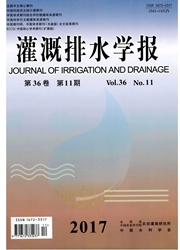

 中文摘要:
中文摘要:
为探究不同种植密度下制种玉米耗水规律及模型适用性,进行了制种玉米的田间小区试验。试验共设置6个种植密度,分别为6.75、8.25、9.75、11.25、12.75和14.25万株/hm^2,采用随机区组布置,每个处理3次重复,其中9.75万株/hm^2为当地种植密度,作为对照(CK)。试验对不同种植密度下的制种玉米的形态指标和耗水量进行了观测。结果表明,制种玉米的LAI随种植密度的增加而增加,株高随种植密度的增加没有显著变化;耗水量随种植密度的增加而增加;相比于双作物系数法、SIMDual Kc模型及引入Kd的双作物系数法而言,K(density)法更适合用于估算西北旱区不同种植密度下制种玉米的Kc值。
 英文摘要:
英文摘要:
Field experiments were conducted from March to September in 2015 to study the law of water consumption and applicability of water consumption model in seed corn with different planting densities. The experimental treatments of six planting densities(67 500, 82 500, 97 500, 112 500, 127 500 and 142 500 plants/hm^2)were laid out in a randomized complete block design with three replicates, and 97 500 plants/hm^2 was the local planting density, which was used as a control treatment. The morphological traits and water consumption of seed corn plants in different densities condition were observed. The results indicated that LAI and water consumption of plants increased with the increase of planting density, and the effect of planting density on crop height was not significant. Compared to the dual crop coefficient method, SIMDual Kcmodel and the dual crop coefficient with Kdmethod, K(density) method had better performance in estimating the value of Kcunder different planting densities of seed corn in an arid region of Northwest China.
 同期刊论文项目
同期刊论文项目
 同项目期刊论文
同项目期刊论文
 期刊信息
期刊信息
